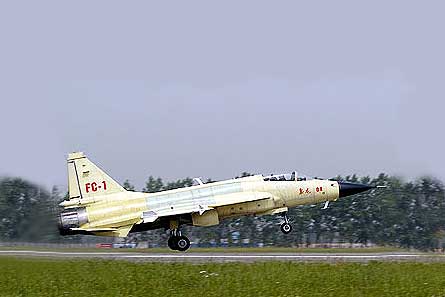By Graham Warwick in London
Changes to China’s Chengdu FC-1 lightweight fighter are clearly visible in recently released photographs (pictured below) of the redesigned fourth prototype’s first flight on 28 April. Joint Strike Fighter (JSF)-style “diverterless” engine inlets lead the design revisions.
In addition to redesigned intakes, the fourth prototype has larger wing leading-edge root extensions, longer ventral strakes either side of the aft fuselage, and a taller, less swept fin. The design changes were made after problems surfaced during testing of the first three prototypes. The FC-1 first flew in August 2003.
|
 |
The redesigned inlets closely resemble those of the Lockheed Martin F-35 JSF. In place of the conventional ramp of the original two-dimensional intake, the new design features a “hump” to aerodynamically divert turbulent boundary-layer airflow away from the engine inlet. Lockheed has said its design is more stealthy than conventional inlets.
Announcing the fourth prototype’s 16min first flight from Wenjiang airport in Chengdu, capital of southwest China's Sichuan Province, Chinese news agency Xinhua said the Xiaolong 04 fighter aircraft has improved electronics and weapon systems. The fighter is powered by a Klimov RD-93 afterburning turbofan – the engine used in the RSK MiG Russian MiG-29.
Pakistan plans to buy up to 150 FC-1s, which it will operate as the JF-17 Thunder. Islamabad has ordered an initial 16 fighters, assembly of which will be split between Chengdu Aircraft and Pakistan Aeronautical Complex. These are to be followed by up to 134 locally assembled aircraft.
Source: Flight International




















